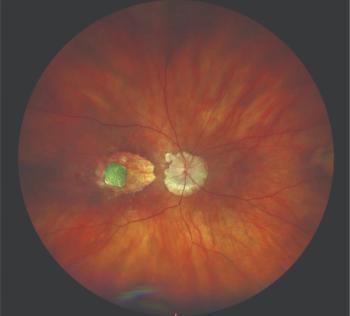
AGS 2024: Travoprost intraocular implant safe and effective in phakic eyes
Steven R. Sarkisian, MD, sat down with David Hutton of Ophthalmology Times to discuss his poster about the Travoprost intraocular implant in phakic eyes from the American Glaucoma Society meeting held in Huntington Beach
Steven R. Sarkisian, MD, sat down with David Hutton of Ophthalmology Times to discuss his poster about the Travoprost intraocular implant in phakic eyes from the American Glaucoma Society meeting held in Huntington Beach
Video Transcript
Editor's note - This transcript has been edited for clarity.
David Hutton:
I'm David Hutton of Ophthalmology Times. The American Glaucoma Society is holding its annual meeting in Huntington Beach, California. At the meeting, Dr. Steven R. Sarkisian is presenting an abstract titled "Standalone Procedure for Administration of Travoprost Intraocular Implant is Safe and Effective in Phakic Eyes." Thanks for joining us today. Tell us about this presentation.
Steven R. Sarkisian, MD:
Well, I'm excited to talk about the iDose in phakic eyes. One of the questions that I often get asked, having been in the Phase II and Phase III of the clinical trials and having now been placed implants commercially, as it's now been available on a very limited rollout. The things people ask me is, is is it safe to do this in the phakic eye. This presentation is specifically about the iDose travaprost intraocular implant and eyes that are phakic. And in the there were 2 large Phase II trials, because the FDA makes you do to 2 trials with any kind of drug study. And of the 1150 patients in the trials, 810 of them were phakic. And you know, they were split between the fast and slow eluding implants and 272 were in the fast eluding, and 268 When the slow eluding and then 270 patients were in the in got Timerol, which was the control group. And the the patients that were randomized to the control group, they were still masked, they entered, they still go to surgery, and they got randomized. The results showed that it's the obviously the iDose works, lowers the pressure significantly. And we saw a very significant drop in pressure from almost 7 to 8.6 millimeters of mercury in the fast loading implant group and 7 to 8.9 millimeters lower pressure lower and drop in the slow eluding implant at 12 months. This really was very significant. And the fact that, really the main issues are, that we saw were a very 2 to 5% rate of inflammation, which was transient and easily treated with steroids. But of interest, none of these patients developed any endothelial cell loss, which is one of the things that is typically asked, and no one involved got a cataract. And so, those are the things when people ask when we're gonna put something in the eye, and what's the risk profile? And I tell you, we demonstrated that the risk profile is very low with this, and all the things that you would be most concerned about, because the iDose is anchored it doesn't move at all. That makes it very safe. And, so again, no cataract and no endothelial cell loss, minimal inflammation, and (it is) very effective. The data speaks for itself, but in my experience, I think that having perfect compliance and having a 24 hour release of medicine inside the eye really makes a big difference in the efficacy. I think over time, we're going to see that other people's experience is going to bear out the stability of visual fields that we have with this implant.
David Hutton:
Ultimately, what can this mean for ophthalmologists and the patients they treat?
Steven R. Sarkisian, MD:
Well, first and foremost we're all about saving vision. And that's that's what matters the most. To reiterate, we know that patient compliance with medications is perfectly really only 10% perfection. You know, if we're going to be optimistic, we'd say 50%. And so eliminating that part of the equation is a really big deal. And this is not a panacea for certain. It is not a cure, but, but this is the kind of thing we've been we've been looking for is to have a sustained-release medicine that, that lasts for an extended period of time. I've followed these patients out, some of them I've seen for 6, 7 years from back to the first Phase II and, and, you know, it does wear off eventually. To improve patient compliance, and this is, you know, just my own sense of things after with based on my experience ... that's really an extension of, outside the scope of the data. But I think that we're definitely going to see more visual field stability in these patients because of the way that the drug is administered. And because it's administered right next to where the organ tissues is trying to augment.
David Hutton:
And lastly, what's the next step for this research?
Steven R. Sarkisian, MD:
Well, I think being able to contemplate combining this with MIGS, you know, with saved from trabecular micro bypass, to really push the envelope and how many medicines we can get people off, and expanding the number of people we can do this on, maybe they have even higher pressures. You know, getting the implant. I'm so excited to take this win, but I'm a restless soul, and I'm always looking for the next thing. And so having iterations of this where it lasts even longer would be great. Making sure that we normalize this, and change hearts and minds of surgeons with continued good data like this. We can get to the point where we're putting one in and letting it last as long as it can, and then exchanging it with another one. You know, maybe having implants with other medications, too. So the sky's the limit is the number of things that we could think of, but that's an excellent question.
Newsletter
Don’t miss out—get Ophthalmology Times updates on the latest clinical advancements and expert interviews, straight to your inbox.





